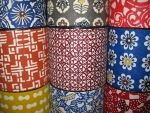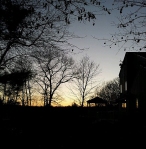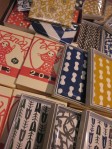2012 over!?! That was amazingly quick. I guess I do spend much of my time on the road and it is clear traveling or rather “not being home” speeds up time!
To switch things up in my dual-life pattern, I spent the fall of 2012 in the East Coast of the US for a change. First DC, then Cleveland (noted in the previous blog. Early November started with a bang, with one the best Paper Connection Annual Holiday Warehouse sales ever! Then, more excitement by mid-November, as my staff and I organized a 4-day visit from a Paper Rock Star guest-Ms. Aimee Lee in Providence, RI. We had an awesome turn out for Ms. Lee’s hanji talk, demo and new book signing: Hanji Unfurled. After Ms. Lee’s successful visit to Rhode Island, I got to enjoy a “real” Thanksgiving with relatives, turkey and pies; it had been many years! Surely a day to recognize all that we have and all that we have in abundance. November, 2012 was certainly packed full with a cornucopia of accomplishments; I am very thankful, no matter what month it is.
By December, 2012, my suitcase was re-packed, and currently I am back on the other side of the globe. Since I’ll be on the road again shortly; heading to Seoul next week, I thought I would turn to TWO past abundant Novembers. Reflecting back as time springs forward.
November, 2011: Journeyed north to Tokohu- the Northeast of Japan: For several reasons, this voyage to Tohoku was quite meaningful, especially post the March 11, 2011 disasters. The main goal was to check on my very good friend, who had moved back to the Tohoku area on March 1, 2011, I hadn’t seen her family since 1986. My friend warned me that all the coastal places we visited in 1986 “ARE GONE”, she wrote days after the tsunami hit. Another reason for going to Tohoku was to get a sense of the general post 3.11 feeling of the Tohoku survivors, where so many mingei-folk arts are/were born. The bonus of this trip was visiting with Mr. Koichi Odanaka at his studio. It was my privilege to meet Mr. Keisuke Serizawa’s last apprentice. I thoroughly enjoyed the back stories Mr. Odanaka told of his life with Mr. and Mrs. Serizawa in Tokyo. So it was a gratifying trip- educational and moving at the same time.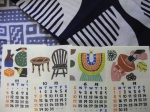
Odanaka’s work is truly irresistible. Although, it’s not something I stock at this point, I would like to support as many artists as possible in the Tohoku region of Japan. Let me know if you’re interested in any of his work; I’ll see what I can do! Here are a few of his stenciled items I purchased: calendar and textiles.
November, 2010: Traveled, by plane, to Toyama-ken for the first time ever.
For centuries Toyama was known as the main pharmaceutical producing area of Japan. Back before plastic bottles with cotton stuffing, all medicines were wrapped with washi. The area was previously known as “Etchu” so the paper from the area is called “Etchu Washi”.
Of course, the need for washi dropped off with the invention of new packaging, but a young Mr. Yoshida, moved back to his hometown of Yatsuo, giving up a city life and a city job to start a washi-making mill in the small, well-preserved town of Yatsuo, not too far from Toyama City. Mr. Yoshida knew he had to make paper for new uses, so he decided to make kozo paper for artwork. Mr. Yoshida befriended the katazome master himself, Mr. Keisuke Serizawa, while he was working up at Ogawamachi in Saitama, making his own paper for his stencil work. Mr. Yoshida convinced Mr. Serizawa to try some Yatsuo paper (Etchu Washi) for his stencil work. From that point forward, Mr. Serizawa used the kozo paper made at Mr. Yoshida’s newly fashioned mill. 
 It was a start of what would become a long business relationship and friendship. Both the Yoshidas and the Serizawa’s had a deep connection with mingei and both had the passion to carry the tradition of washi and katazome into the future. Currently, the next generation of the Yoshida family run a paper shop, mill and incredible folk art museum, which houses the collection of the Yoshida parents. Thanks to the friendship between the Yoshida family and the Serizawa family, this Yatsuo operation called Keijyusha continues to produce decorated katazome papers, stationery items and collectible calendars employing Serizawa’s original stencils.
It was a start of what would become a long business relationship and friendship. Both the Yoshidas and the Serizawa’s had a deep connection with mingei and both had the passion to carry the tradition of washi and katazome into the future. Currently, the next generation of the Yoshida family run a paper shop, mill and incredible folk art museum, which houses the collection of the Yoshida parents. Thanks to the friendship between the Yoshida family and the Serizawa family, this Yatsuo operation called Keijyusha continues to produce decorated katazome papers, stationery items and collectible calendars employing Serizawa’s original stencils.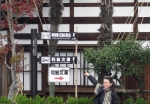
There are still a few 2013 Serizawa desk calendars for sale at Paper Connection and many beautiful items in stock and for sale from this precious operation in Yatsuo. Please call us or email us for more information.